Basic HTML Version




HOOK NORTON
VETERINARY GROUP
For further information please visit
www.hooknortonvets.co.uk
practice
news...
For the second year running we have
frozen our vaccination prices for
2010/2011. Pet Vaccinations will be
kept at the 2008 prices. Discounts apply
for multiple pets. We have also frozen
our neutering prices which remain at
2009 prices.
Please speak to our Reception team on
01608 730501 for more information.
Special
'Credit Crunch'
Offer for 2010
The practice offers
FREE
Senior Pet Health
Care Check-Ups for all cats and dogs over
the age of 9 years which are otherwise
well. The check up will give us the
opportunity to examine your pet and pick
up on any potential health problems early
which can result in more effective or
successful treatment. Check-ups will take
place at our Hook Norton surgery where
your pet will be seen first by a qualified
Nurse who will test a urine sample (dogs) or
take the blood pressure measurement (cats).
A blood sample (at a reduced cost of
£11.75 including vat) will be taken to get
a fuller picture of your pet's kidney and liver
function. The Vet will then perform a full
physical examination and discuss any
findings along with any of your questions.
For more details and to book your pet's
Senior Health Check-Up please call the
Hook Norton surgery on 01608 730501.
FREE
SENIOR PET
HEALTHCARE CHECKS
Acupuncture is performed by two of our
companion animal vets. Pauline Tolhurst at
the Charlbury surgery and Jan Guilbride at
the Hook Norton surgery, both of whom
have completed the approved veterinary
course and are members of the Association
of British Veterinary Acupuncture recognised
by the Royal College of Veterinary Surgeons.
Acupuncture sessions involve a 20 minute
consultation so that the pet can be examined
thoroughly, and the needles left in for the
appropriate length of time (generally
10 - 20 minutes).
Please contact reception on 01608
730501 to make an appointment.
ACUPUNCTURE
Small Talk
is published by:
XLVet UK Ltd, Carlisle House, Townhead Road, Dalston, Carlisle CA5 7JF
© XLVet UK Ltd
No part of this publication may be reproduced without prior permission of the publisher.
Disclaimer:
XLVets does not necessarily share the views of contributors. No responsibility can be accepted for opinions
expressed by contributors, or claims made by advertisers within this publication.
W
hereas in people the most common
forms of arthritis are related either to old
age (wear and tear of a normal joint over time)
or primary inflammation (such as rheumatoid
arthritis), in dogs arthritis is most commonly
the result of abnormal wear and tear of a joint
due to an underlying conformational problem.
For instance, in a dog with hip dysplasia the
normal shape of the ball and socket joint fails
to develop so that the edge of the socket
wears against the surface of the ball. This
results in damage to the cartilage and sets
up a vicious cycle of degeneration that will
continue throughout the dog's life.
Arthritis cannot be cured and arthritic changes
cannot be reversed, but steps can be taken to
slow the progression of joint disease and to
alleviate the symptoms associated with the
condition. The three most important aspects
of treating arthritis are:
1. Pain relief
- by the use of anti-inflammatory
drugs. Initially this may be intermittent to
combat pain from flare-up episodes, but may
need to become long-term treatment as the
condition worsens. Fortunately the modern
range of such drugs are extremely safe and
efficacious for our patients.
2. Weight loss
- recent studies have confirmed
that the majority of dogs in the UK are
overweight! Force-plate studies at Universities
have shown that the peak force transmitted
through a joint for a dog trotting beside its
owner is up to five times its bodyweight.
A small weightloss can therefore make a
big difference to the degree of force - and
ongoing damage - put through a joint.
3. Exercise modification
- exercise is beneficial
for diseased joints, because it improves
blood-flow, strengthens supporting muscles
and maintains the pliability of the thickened,
stiffened tissues that surround a joint.
However the type of exercise is important:
controlled regular exercise is almost always
beneficial, but high impact exercise such
as ball-chasing can be very damaging.
An appropriate exercise regime needs to be
tailored to each individual patient and may
need to change in response to flare-up
episodes of joint pain and inflammation.
There is wide interest in various supplements
and alternative treatment modalities. Results
from these are often conflicting at best, so the
above ‘Holy Trinity’ of arthritis management
should always be in place before other
methods are considered. Basic massage and
physiotherapy techniques are easily learned
and can be very useful in certain cases.
Regular checks with a vet who knows your
pet and its joints well form the cornerstone
of treatment and will allow the vet to advise
appropriately on subtle changes in your
pet's condition.
Arthritis is one of the most common disease
conditions seen in dogs and is frequently
becoming recognised in cats too.
A hip with severe arthritis
A normal hip joint
by
Tim Hutchinson,
Larkmead Veterinary Group
